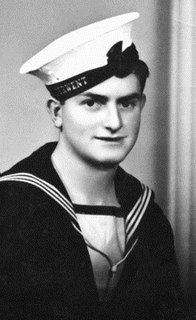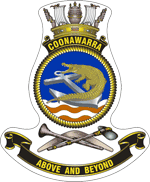Three ships and two shore installations of the Royal Australian Navy have been named HMAS Penguin after the aquatic, flightless bird:

The Type 97 was a 17.7 inches (45 cm) diameter torpedo used by the Imperial Japanese Navy during World War II. Intended for use with Japan's Kō-hyōteki-class midget submarines, the torpedo was based on the 24-inch diameter Type 93 "Long Lance" used by Japanese surface vessels, but redesigned to meet the smaller 18-inch physical dimensions of the midgets' two torpedo tubes. Larger Japanese submarines were armed with the 21-inch Type 95 torpedo.

Garden Island is an inner-city locality of Sydney, Australia, and the location of a major Royal Australian Navy (RAN) base. It is located to the north-east of the Sydney central business district and juts out into Port Jackson, immediately to the north of the suburb of Potts Point. Used for government and naval purposes since the earliest days of the colony of Sydney, it was originally a completely-detached island but was joined to the Potts Point shoreline by major land reclamation work during World War II.

HMAS Kuttabul, formerly SS Kuttabul, was a Royal Australian Navy depot ship, converted from a Sydney Ferries Limited ferry.

In late May and early June 1942, during World War II, submarines belonging to the Imperial Japanese Navy made a series of attacks on the Australian cities of Sydney and Newcastle. On the night of 31 May – 1 June, three Ko-hyoteki-class midget submarines, each with a two-member crew, entered Sydney Harbour, avoided the partially constructed Sydney Harbour anti-submarine boom net, and attempted to sink Allied warships. Two of the midget submarines were detected and attacked before they could engage any Allied vessels. The crew of M-14 scuttled their submarine, whilst M-21 was successfully attacked and sunk. The crew of M-21 killed themselves. These submarines were later recovered by the Allies. The third submarine attempted to torpedo the heavy cruiser USS Chicago, but instead sank the converted ferry HMAS Kuttabul, killing 21 sailors. This midget submarine's fate was unknown until 2006, when amateur scuba divers discovered the wreck off Sydney's northern beaches.

Edward "Teddy" Sheean, was a sailor in the Royal Australian Navy during the Second World War. Born in Tasmania, Sheean was employed as a farm labourer when he enlisted in the Royal Australian Naval Reserve in April 1941. Following training at HMAS Derwent and the Flinders Naval Depot, he was posted to Sydney, where he joined the newly commissioned corvette HMAS Armidale in June 1942. Sheean served aboard Armidale as she took part in escort duties along the eastern Australian coast and in New Guinea waters. In October he transferred with the ship to Darwin, where Armidale was tasked with assisting Australian operations in Timor.

HMAS Coonawarra is a Royal Australian Navy (RAN) base located in Darwin, Northern Territory, and is home to twelve fleet units of the RAN. The current commander is Captain Moses Raudino, HADC, RAN.

HMAS Warrego, named for the Warrego River, was a River-class torpedo-boat destroyer of the Royal Australian Navy (RAN). Ordered in 1909, construction of the destroyer started in England, but she was then broken down and reassembled at Cockatoo Island Dockyard in order for the Australian shipbuilding industry to gain experience in warship construction. Warrego was commissioned into the RAN in 1912, and spent her early career operating in Australian waters.

HMAS Penguin is a Royal Australian Navy (RAN) base located at Balmoral on the lower north shore of Sydney Harbour in the suburb of Mosman, New South Wales. Penguin is one of the RAN's primary training establishments, with a responsibility for providing trained specialists for all areas of the navy. The current commander of Penguin is Commander Bernadette Alexander, RAN.

HMAS Kuttabul is a Royal Australian Navy (RAN) base located in Potts Point in Sydney, New South Wales, Australia. Kuttabul provides administrative, training, logistics and accommodation support to naval personnel assigned to the various facilities that form Fleet Base East, the main operational navy base on the east coast of Australia. A part of Fleet Base East itself, Kuttabul occupies several buildings in the Sydney suburb of Potts Point and in the immediately adjacent Garden Island dockyard. It also supports navy personnel posted to other locations throughout the greater Sydney region.

The Fleet Base East is a Royal Australian Navy (RAN) major fleet base that comprises several naval establishments and facilities clustered around Sydney Harbour, centred on HMAS Kuttabul. The Fleet Base East extends beyond the borders of Kuttabul and includes the commercially-operated dockyard at Garden Island, and adjacent wharf facilities at nearby Woolloomooloo, east of the Sydney central business district in New South Wales, Australia. Fleet Base East is one of two major facilities of the RAN, the other facility being the Fleet Base West. The fleet operates in the Pacific Ocean.
Several ships and shore establishments of the Royal Australian Navy have been named HMAS Platypus, after the platypus:

HMAS Tarakan (L3017) was a Mark III Tank Landing Ship, or LST(3), that served in the Royal Navy (RN) during 1945 and 1946 and Royal Australian Navy (RAN) from 1946 until 1954.

The Garden Island Naval Chapel is a heritage-listed non-denominational Christian chapel located in the heritage-listed Garden Island Naval Precinct that comprises a naval base and dockyard in the inner eastern Sydney suburb of Garden Island in the City of Sydney local government area of New South Wales, Australia. Housed in a building designed by James Barnet and built between built 1886 and 1887, the chapel was established in 1902 after conversion from the former sail loft and is the oldest Christian chapel of the Royal Australian Navy (RAN) and has stained glass windows and plaques from that era to the present. The chapel was added to the Commonwealth Heritage List on 22 June 2004 and the New South Wales State Heritage Register on 12 November 2004.
One ship and one shore base of the Royal Australian Navy have been named HMAS Leeuwin, after Cape Leeuwin in Western Australia.
HMAS Stalwart was an Australian-designed and constructed Escort Maintenance ship of the Royal Australian Navy (RAN). Commissioned on 9 February 1968 and decommissioned on 9 March 1990, Stalwart served as a destroyer tender, the RAN flagship, and a training vessel during her career. She was sold in 1993 for conversion into a short-range cruise ship, under the names MV Her Majesty M, then MV Tara II. The vessel did not enter civilian service before she was broken up for scrap in 2003.
HMAS Maitland is a former Royal Australian Navy (RAN) shore-based naval depot located in the Hunter area, behind Horseshoe Beach and Nobby's Beach, in Newcastle, New South Wales, Australia.
Two units of the Royal Australian Navy (RAN) have been named HMAS Rushcutter, for Rushcutters Bay, New South Wales.
M24 Japanese Midget Submarine wreck site is a heritage-listed former midget submarine and now archaeological site located in unincorporated waters off Sydney's Northern Beaches in New South Wales, Australia. The Ko-hyoteki-class midget submarine was designed by the Japanese Imperial Navy and built from 1941 to 1942 by Kure Naval Yard or Ourazaki Naval Yard. The site was added to the New South Wales State Heritage Register on 7 December 2007.










